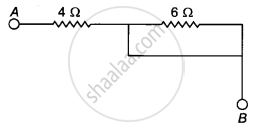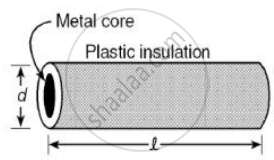Advertisements
Advertisements
प्रश्न
Why are copper and aluminium wires usually employed for electricity transmission?
उत्तर
Copper and aluminium wires are often used to transmit electricity because:
- Copper and aluminium are good conductors of electricity also have low resistivity.
- Copper and aluminium have a low resistance, which makes them good conductors of electricity.
- Wires can be made easily from these.
संबंधित प्रश्न
On what factors does the resistance of a conductor depend?
A copper wire has diameter 0.5 mm and resistivity of 1.6 × 10−8Ω m. What will be the length of this wire to make its resistance 10 Ω? How much does the resistance change if the diameter is doubled?
Which has less electrical resistance : a thin wire or a thick wire (of the same length and same material)?
Classify the following into good conductors, resistors and insulators:
Rubber, Mercury, Nichrome, Polythene, Aluminium, Wood, Manganin, Bakelite, Iron, Paper, Thermocol, Metal coin
What happens to the resistance as the conductor is made thinner?
Which among iron and mercury is a better conductor of electricity?
A wire is 1.0 m long, 0.2 mm in diameter and has a resistance of 10 Ω. Calculate the resistivity of its material?
Calculate the resistance of a copper wire 1.0 km long and 0.50 mm diameter if the resistivity of copper is 1.7 × 10−8 Ω m.
How does the resistance of a conductor depend on:
length of the conductor?
Calculate the area of cross-section of a wire if its length is 1.0 m, its resistance is 23 Ω and the resistivity of the material of the wire is 1.84 × 10−6 Ω m.
How will you infer with the help of an experiment that the same current flows through every part of the circuit containing three resistors R1, R2 and R3 in series connected to a battery of V volts?
The effective resistance between A and B is:

A cylindrical conductor of length l and uniform area of cross-section A has resistance R. Another conductor of length 2l and resistance R of the same material has an area of cross-section:
Assertion: Conductors allow the current to flow through themselves.
Reason: They have free charge carriers.
How will you infer with the help of an experiment that the same current flows through every part of the circuit containing three resistances in series connected to a battery?

Plastic insulation surrounds a wire having diameter d and length l as shown above. A decrease in the resistance of the wire would be produced by an increase in the ______.
The resistance of a wire of 0.01 cm radius is 10 Ω. If the resistivity of the wire is 50 × 10-8 Ω, find the length of this wire.
